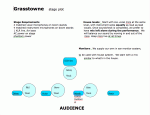 As a new year gets underway, many of us are probably working out new arrangements to songs and beginning to think through what our band’s show is going to look like during the 2011 season. If you’re like me, you’re always looking for ways to make things better than they were before. Here’s are a couple little things you can do to help the sound man help you sound better at each show. This holds true regardless of venue.
As a new year gets underway, many of us are probably working out new arrangements to songs and beginning to think through what our band’s show is going to look like during the 2011 season. If you’re like me, you’re always looking for ways to make things better than they were before. Here’s are a couple little things you can do to help the sound man help you sound better at each show. This holds true regardless of venue.
First, give him a stage plot. Just a simple diagram showing your band’s arrangement on stage and input needs. Give it to the soundperson early, don’t wait till just before you’re suppose to be on stage. Give it to him as soon as you arrive at the venue, and have an extra copy just in case he looses it. Check in with him shortly before your performance and ask if he needs another copy or anything else from you.
Giving the sound person a stage plot will let them know how you’ll need mic stands distributed, what kind of inputs you’ll need (vocal mics, instrument mics, direct inputs for any instrument that is plugging in, etc.), and any AC power requirements you might have. This makes the sound crew’s job much easier, and allows them to prepare ahead of time, making both the venue and yourself look much more professional in the eyes of the audience. The crowd, the sound crew, and the promoter will all appreciate this little bit of effort on your part that will make the show run smoothly and on time.
Second, give the soundperson an enhanced set list. The list you give him needs to have a little more info than just the song titles and keys. The sound person needs to know a little bit about each arrangement: who’s kicking the tune off, any particular dynamic changes that might happen, and how does it end. Letting the sound crew know that the guitarist will be kicking off a particular tune, or that there is a bass solo in the middle of one tune, or that this song has a special ending, will allow them to be in sync with you, rather than adjusting levels reactively as you surprise them with large dynamic changes on the fly. Trust me, they’ll be happier, you’ll be happier, and most importantly you’ll sound better to the audience.
A word of caution: don’t write a novel. Keep it short. One page is preferable. The sound engineer is busy, especially if there are multiple bands playing the same venue (such as a festival). If you hand him a 3-ring binder that looks like an in depth user manual, odds are he’ll ignore it. So keep it to one page if at all possible.
Be sure to have several copies of both the stage plot and the enhanced set list available with you, just in case there is a separate monitor mix position, you’ll want to the monitor engineer to have the same documents.
Thinking through your sound requirements and helping the sound crew out, is really helping yourself out. You care about your music and you’ve put a lot of effort into that awesome new arrangement, invest this small amount of time in making sure the audience can hear it as you intended it to be.
Here are some links to a few examples of stage plots I managed to track down for bluegrass band’s you’re probably familiar with.







